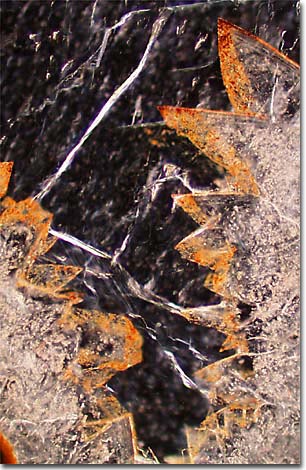Darkfield Microscopy Image Gallery
Cretaceous Dinosaur Fossil
The photomicrograph below is a darkfield image of a thin section made from a dinosaur (unknown species) fossil from the Cretaceous period that was recovered in Argentina.

The Cretaceous period began 144 million years ago and ended 65 million years ago, at the beginning of the period marking the start of dinosaur extinction. This was the last period of the Mesozoic Era, and the general dinosaur population increased during much of this period.
Fossilized dinosaur bones come in a variety of forms depending on how they have been petrified. Most dinosaur bones have been petrified with calcium, which yields a stony appearance and texture. Agatized bones are petrified with silica, or quartz crystals, giving them a colorful, glassy appearance. Fossilization occurs when hard parts from a dead plant or animal are buried quickly in sediments and exposed to mineralized solutions over long periods of time. Minerals dissolved in ground waters infiltrate the organic tissues, filling the spaces within and between cells, gradually embedding and preserving the tissue structure. On rare occasions, even soft body parts, eggs, and feces have been fossilized.
For bones to become agatized, a process called permineralization occurs in which groundwater, rich in silicon dioxide (silica), infiltrates the bone. The mineral rich solution fills the spaces of the bone with silica crystals, eventually forming patterns of colorful quartz. Agatized bones, such as the specimen presented in the photomicrograph, are only found in areas of the world that were rich with silica minerals at the time the bones were fossilizing. In the United States, the largest deposits of agatized dinosaur bones are concentrated in Colorado and Utah.
